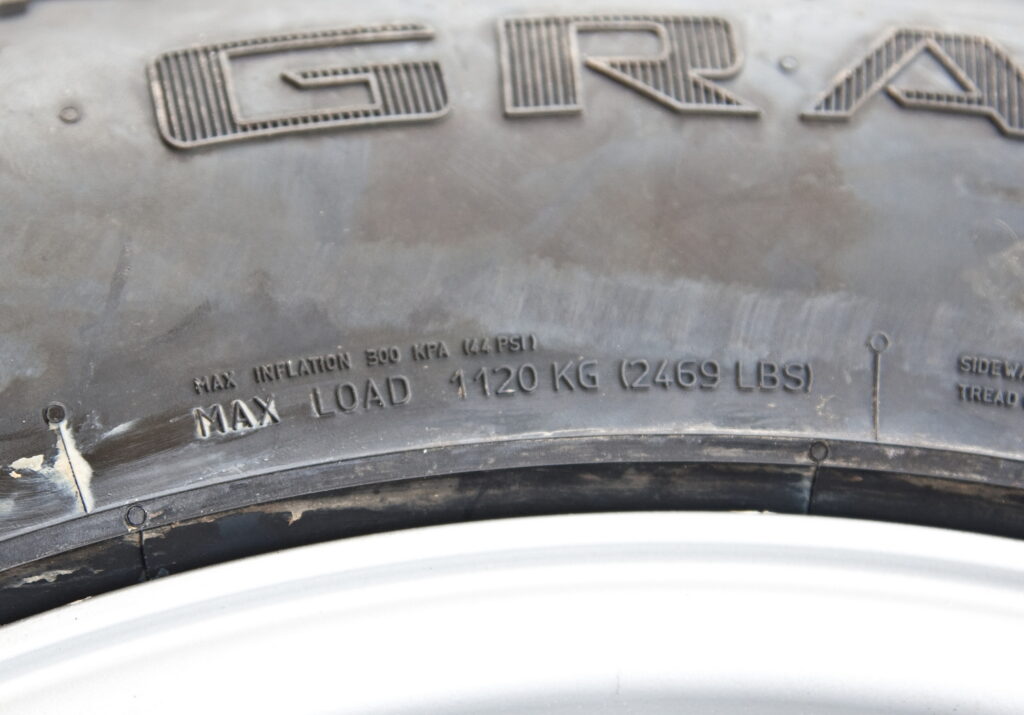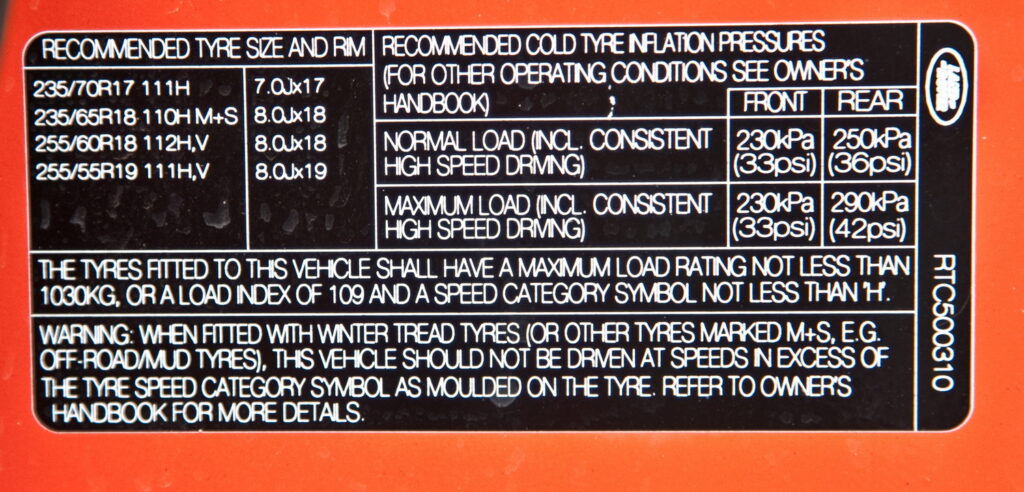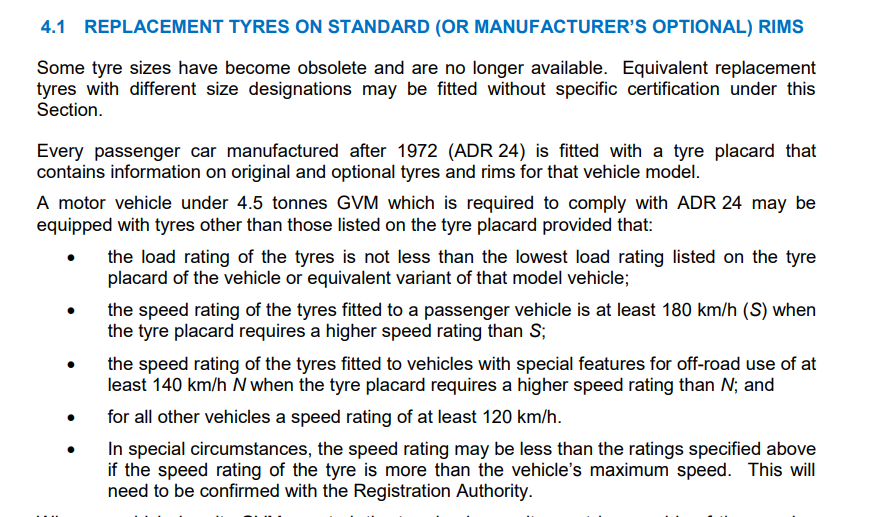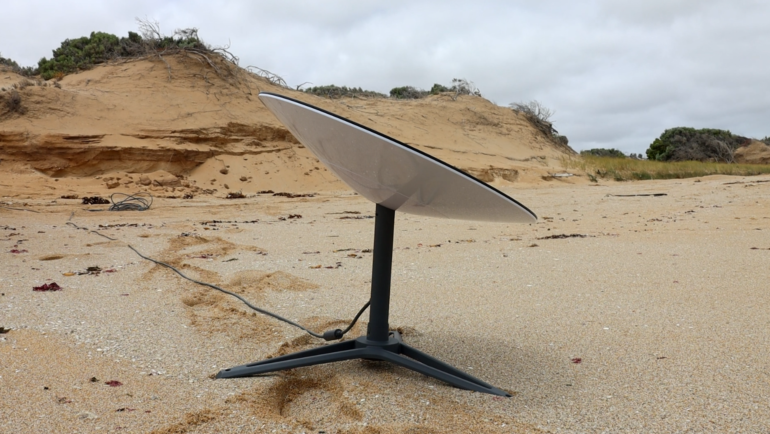
I can’t find appropriately speed-rated tyres for my 4×4 in Australia!
Every tyre has a speed rating and a load rating. The speed rating is the maximum speed the tyre should be run at, and the load rating is the maximum load the tyre can take, and complying with these ratings can cause problems when you change tyres.
The speed ratings are letters, e.g. V = 240km/h, S = 180km/h, N = 140km/h. The load ratings are numbers that correspond to the rating in kg, e.g. 116 = 1285kg, 120 = 1400kg. There may be two load ratings on a 4×4 tyre; that’s because such tyres may be run on a dual-wheel configuration on trucks, and the inside tyre runs a little hotter due to lack of airflow, and to allow a safety margin in the case of one tyre being punctured. For 4×4 use, take the higher load rating as it’s single use.
The title image shows a tyre of rating 112S. You may also see a load rating expressed directly in kilograms like this:

Your 4×4 will also have a placard on which the carmaker has specified minimum load and speed ratings for tyres, eg 116S. Legally, you cannot fit a tyre which doesn’t match or exceed the tyre load and speed ratings. The example below is a Discovery 3 with tyre rating from 110H to 112V depending on tyre size. The “M+S” is Mud and Snow, and not directly relevant to the ratings.

It’s not unusual to find different ratings for different tyre sizes. Happily the placard summarises the minima as 1030kg (109) and speed H, which is a rather rapid 210km/h. Not all placards do that so nicely.
Anyway, these ratings present a problem for offroading 4×4 owners because we like to fit offroad tyres which are stronger construction with thick carcasses, tough sidewalls and deep treads. That means the load rating is no problem, but the heavy, tough tyre cannot dissipate heat effectively and so it ends up with a low speed rating, and often lower than the car’s placard. This would normally make the tyre an illegal fitment.
However, this is an exemption. In a very rare moment of collective intelligence, the Australian road authorities have said this:

So, all you need is tyre rated for N (140km/h) for your 4×4, which is pretty slow so all but the most extreme tyres will be compliant.
Now “special features for offroad use” is a bit subjective, but the definitive answer is that the vehicle is classified as MC, i.e.:
4.3.3. OFF-ROAD PASSENGER VEHICLE (MC)
A passenger vehicle having up to 9 seating positions, including that of the driver and being designed with special features for off-road operation. A vehicle with special features for off-road operation is a vehicle that:
(a) Unless otherwise ‘Approved‘ has 4 wheel drive; and
(b) has at least 4 of the following 5 characteristics calculated when the vehicle is at its ‘Unladen Mass‘ on a level surface, with the front wheels parallel to the vehicle’s longitudinal centreline, and the tyres inflated to the ‘Manufacturer‘s’ recommended pressure:
(i) ‘Approach Angle‘ of not less than 28 degrees;
(ii) ‘Breakover Angle‘ of not less than 14 degrees;
(iii) ‘Departure Angle‘ of not less than 20 degrees;
(iv) ‘Running Clearance‘ of not less than 200 mm;
(v) ‘Front Axle Clearance‘, ‘Rear Axle Clearance‘ or ‘Suspension Clearance‘ of not less than 175 mm each.
Alternatively, a vehicle that meets the definition of CATEGORY G – OFF-ROAD VEHICLES under Consolidated Resolution on the Construction of Vehicles (R.E.3) of the United Nations Economic Commission for Europe and is in category M1.
Source: https://www.legislation.gov.au/Details/F2012C00326
I think it could be easily argued that low range, cross-axle or centre differential locks etc are also Offroad Features.
So, bottom line is that if you have a 4X4 in Australia, you need fit only N speed rated tyres, and match or exceed the load rating. That shouldn’t restrict your offroad tyre choice to any significant degree, so you can go fit suitable rubber for your travels.
If you want to know more about tyre sizes, then you can use my tyre calculators, and watch the videos below:


